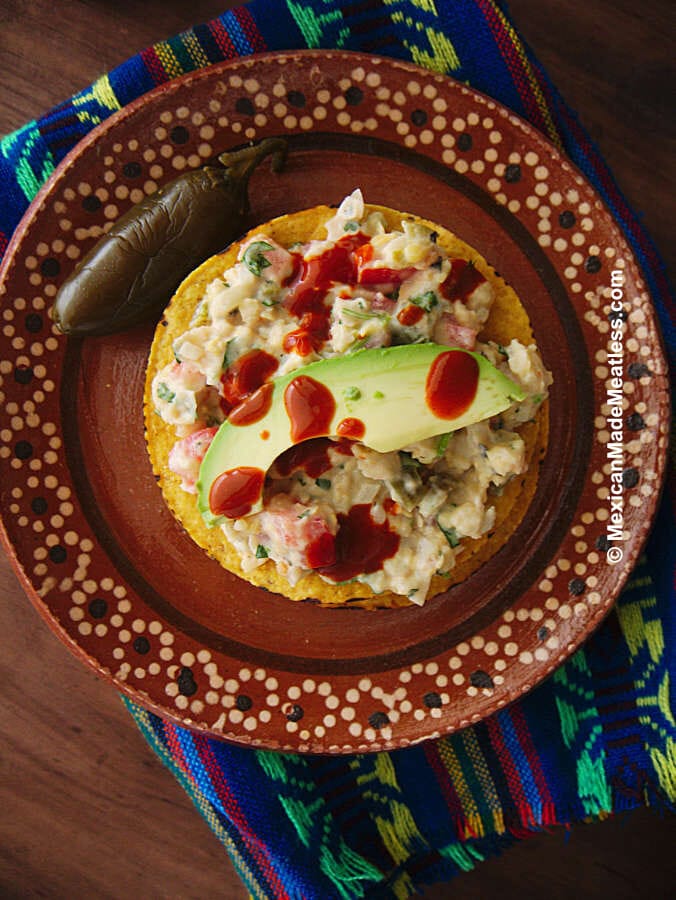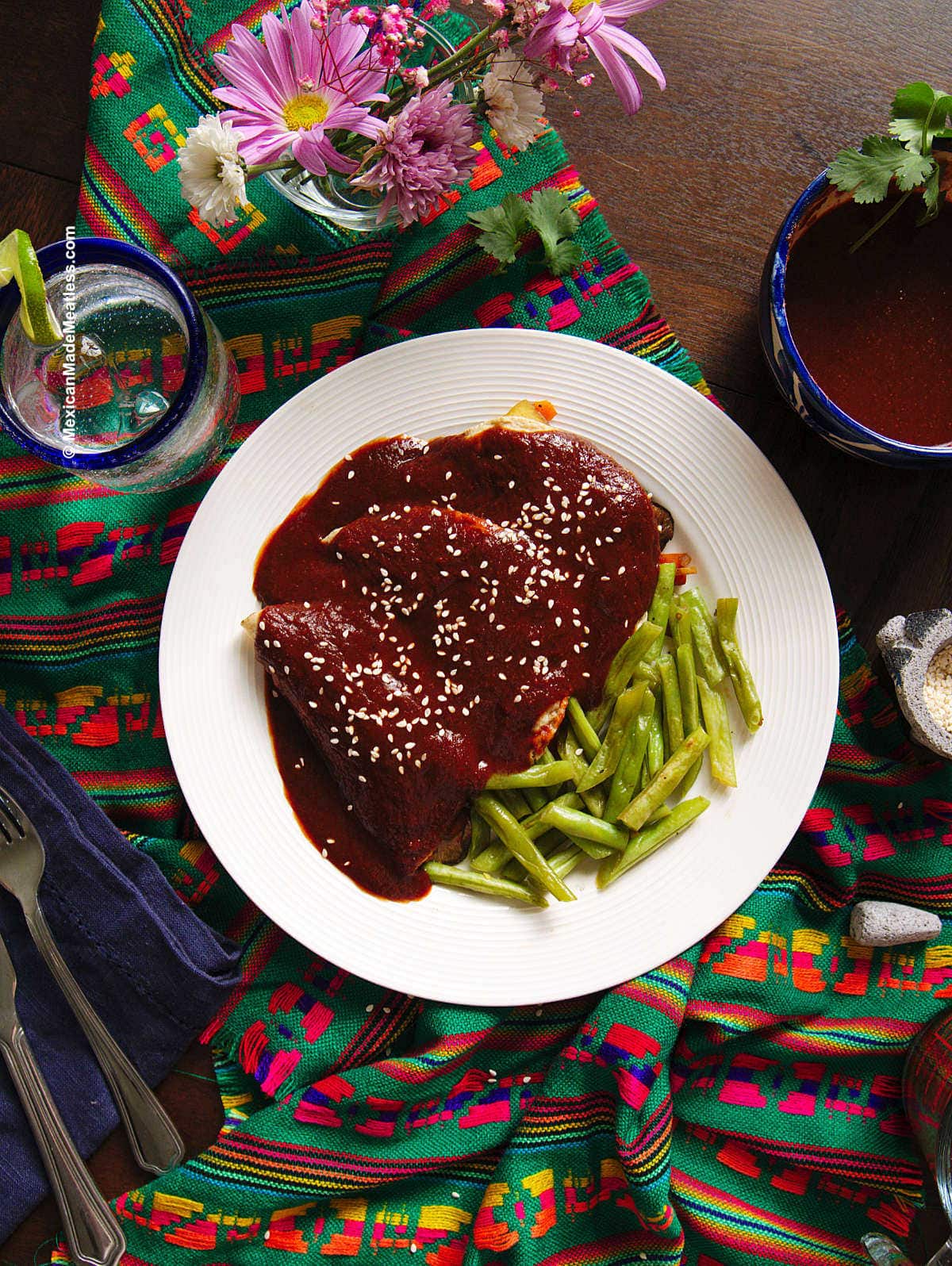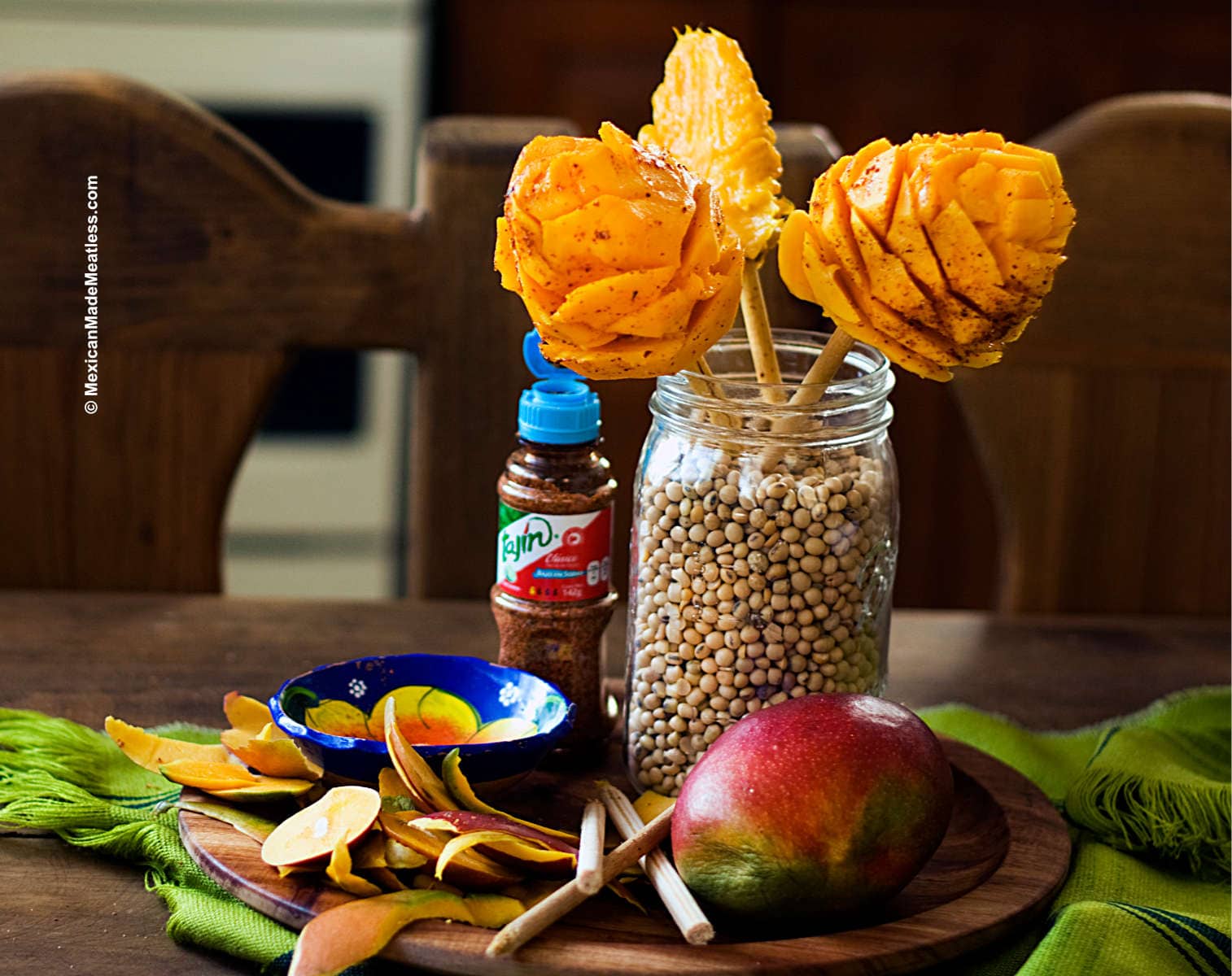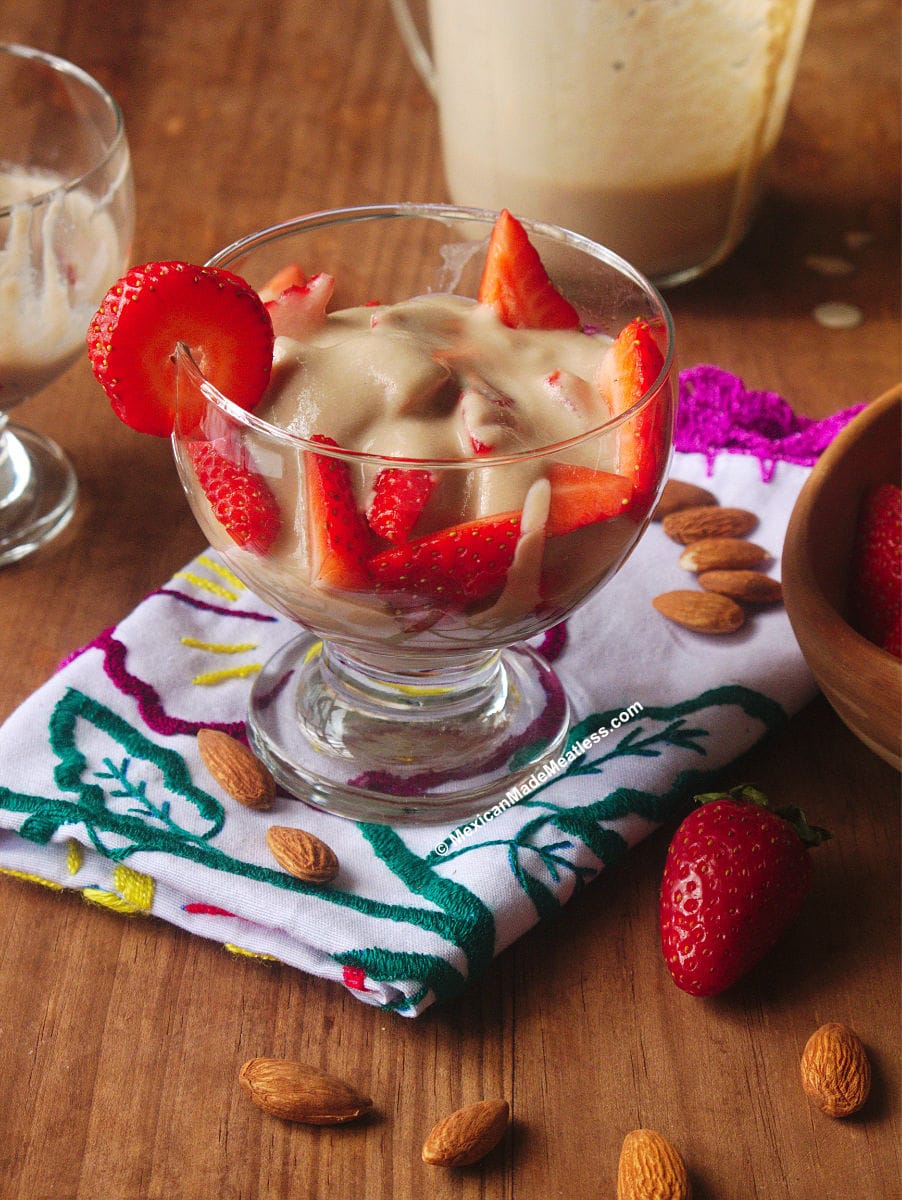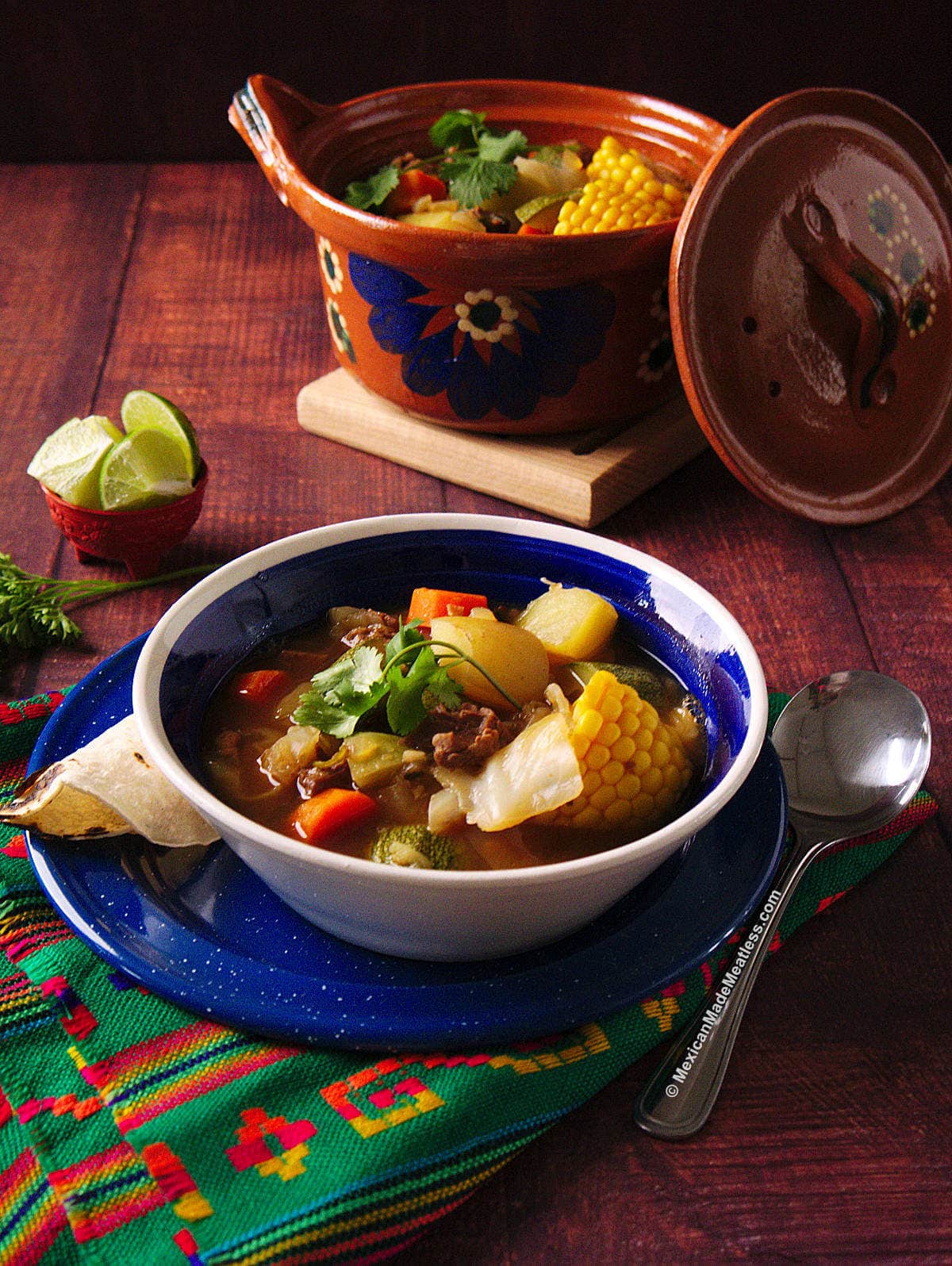Banana Leaf Tamales Recipe with Cochinita Pibil Filling
Across Southern Mexico and costal areas like Oaxaca and Veracruz, banana leaf tamales are made instead of corn husk wrapped ones. You’re going to love my banana leaf tamales recipe filled with tender cochinita pibil and topped with zesty pickled red onions and habanero salsa, all with a plant based twist.
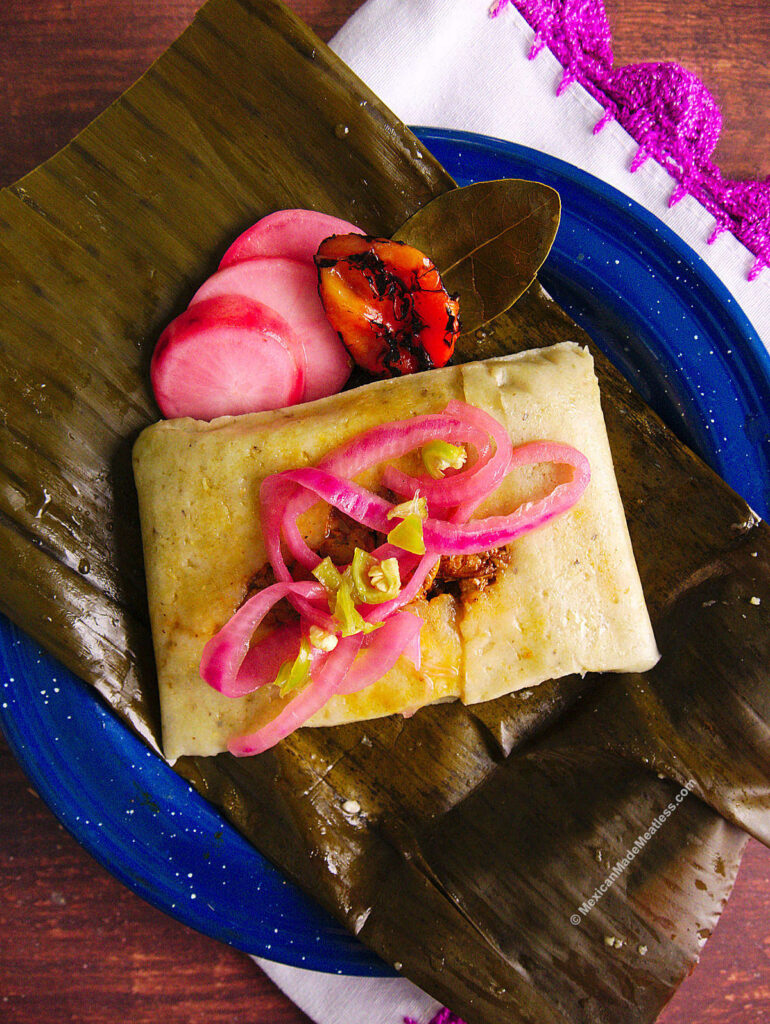
Banana Leaf Tamales
The tamales most people are familiar with are ones wrapped in corn husks. But across the Southern and some coastal states of Mexico, Central America and other parts of Latin America, banana-wrapped tamales are more common.
The use of banana leaves imparts a subtle earthy aroma and gives the tamales a distinct look compared to the corn husk wrapped ones.
In most cases the banana leaf tamales are cooked using the steaming method like with corn husk tamales, but also often times they can be baked in the oven or in an earth oven dug into the ground. Such is the case with the traditional tamales of the Yucatan Peninsula.
Another difference is that banana leaf tamales are stacked on top of each other when steamed, rather than steamed standing up like corn husk ones.
The type of Mexican tamales I grew up eating were the ones wrapped in corn husks. But now having lived in Southern Mexico for nearly 10 years, I can honestly say that the banana leaf tamales are just as delicious. Each type is different but delicious in their own right nonetheless.
I’ve shared many tamales recipes here on the blog, and even wrote a tamales cookbook where 99% of the tamales are made using corn husks. But today I’m going to be sharing a scrumptious banana leaf tamales recipe that I just know you’re going to love.
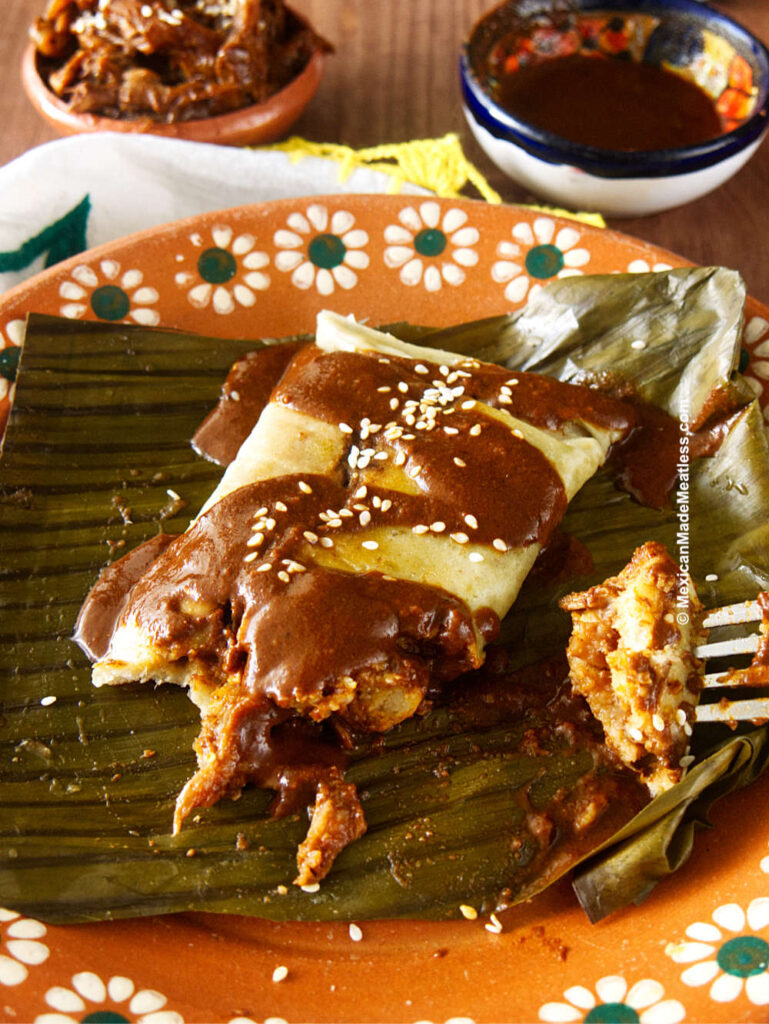
Traditional Banana Leaf Tamale Fillings
When it comes to the fillings for banana leaf tamales, the possibilities are endless. Some of the more popular are tamales Oaxaqueños which can be filled with pork, chicken, or vegetables and even vegetarian filling options exist.
These tamales can have a red sauce, green sauce or a creamy mole sauce. In Northern Mexico some banana leaf tamales are filled with beans and cheese, and there even exist fish fillings.
While traditionally filled with meat, seafood, and vegetables, the beauty of tamales lies in their versatility. This opens the door for creative and delicious adaptations that can easily be made plant-based with scrumptious results.

Cochinita Pibil Tamales
For those unfamiliar, cochinita pibil is a slow-cooked pork dish originating from the Yucatán Peninsula in Mexico. It is marinated in citrus juices, herbs and spices, and achiote paste and cooked wrapped in banana leaves.
Traditionally cochinita pibil is cooked in a “pib” or earth oven. The most common way to eat cochinita is with corn tortillas as tacos or as a filling for panuchos, salbutes, and tortas.
It’s not common to see cochinita pibil tamales, but to me it makes perfect sense to use cochinita as a delicious tamales filling. So that’s what you see before you, mouthwatering banana leaf tamales filled with cochinita pibil.
Being that this, of course, is a meatless recipe blog, my cochinita pibil is made plant based and I used oyster mushrooms to replace the pork.
Let me tell you that the results are scrumptious and do not disappoint! The tender oyster mushrooms, infused with the citrusy notes, achiote paste, and traditional spices is a symphony of textures and flavors, wrapped in the warm earthy embrace of banana leaves.
I shared these plant based tamales with meat eaters and they all quite enjoyed them, so I know you will too.

Why You’ll Love These Banana Leaf Tamales
- Banana leaf tamales taste different than corn husk ones, and it’s a great way to expand your tastebuds.
- These plant-based tamales are perfect for non-meat eaters and carnivores.
- The cochinita pibil filling is a unique tamale filling that’s very much worth a try.
- You can stack the tamales in the steamer pot rather than having to stand them up.
- Banana leaves give tamales a unique flavor that gives the tamales an extra special touch.
- Banana leaf tamales are quite easy to make!
Are These Tamales Vegan?
Yes they are! The recipe uses oyster mushrooms to replace the pork in the cochinita pibil. These mushrooms work perfectly because they have a meaty texture and can be seasoned and cooked to mimic the flavors of the traditional meat dishes, like cochinita pibil filling, seamlessly.
If you haven’t noticed yet, I use oyster mushrooms a lot just for this reason.
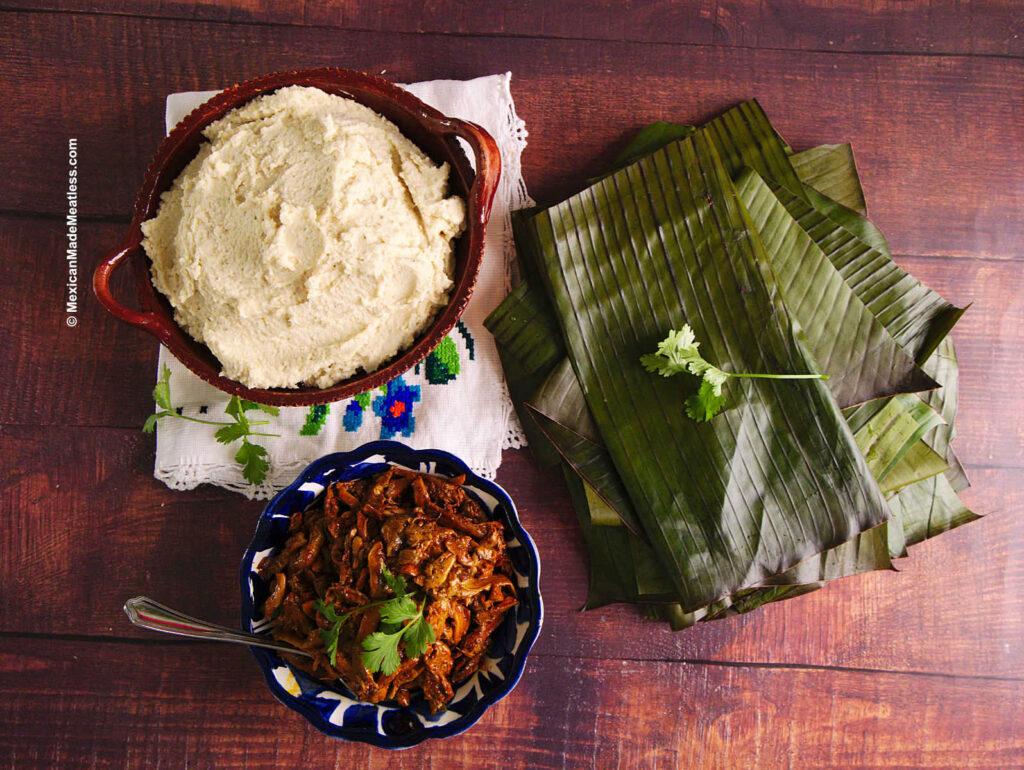
Ingredients Needed
Make sure to have all these ingredients ready before you begin the cooking process. Having everything prepared will ensure a smooth cooking experience and delicious results with your banana leaf tamales.
- Tamale Masa: You can use either fresh masa or masa harina to make your tamale masa. I have a couple different masa recipes for you to choose from. For this recipe I used my tamales masa with oil and the recipe is written in the recipe card.
- Cochinita Pibil Filling: We’ll using my recipe for plant-based cochinita and the full recipe is in the recipe card below.
- Fresh Banana Leaves: In the United States you can find them at Mexican markets, Asian markets or any grocery stores that international foods. You’ll either find them on store shelves in the frozen food section. There’s also Amazon.
- Pickled Onions and Habanero Salsa: These are for topping and serving your tamales. I have also previously shared the recipe.
How to Make Banana Leaf Tamales with Cochinita Pibil Filling
I’ve said it many times and I’ll say it again, making tamales isn’t difficult at all. All you need to do be patient because though not difficult, making tamales is an involved process that requires some time.
Please note that the recipe is using masa harina instead of fresh masa because I know many of you can only get masa harina.
Step 1: Make The Filling
You can make the filling the day before to help cut down the work in one day.
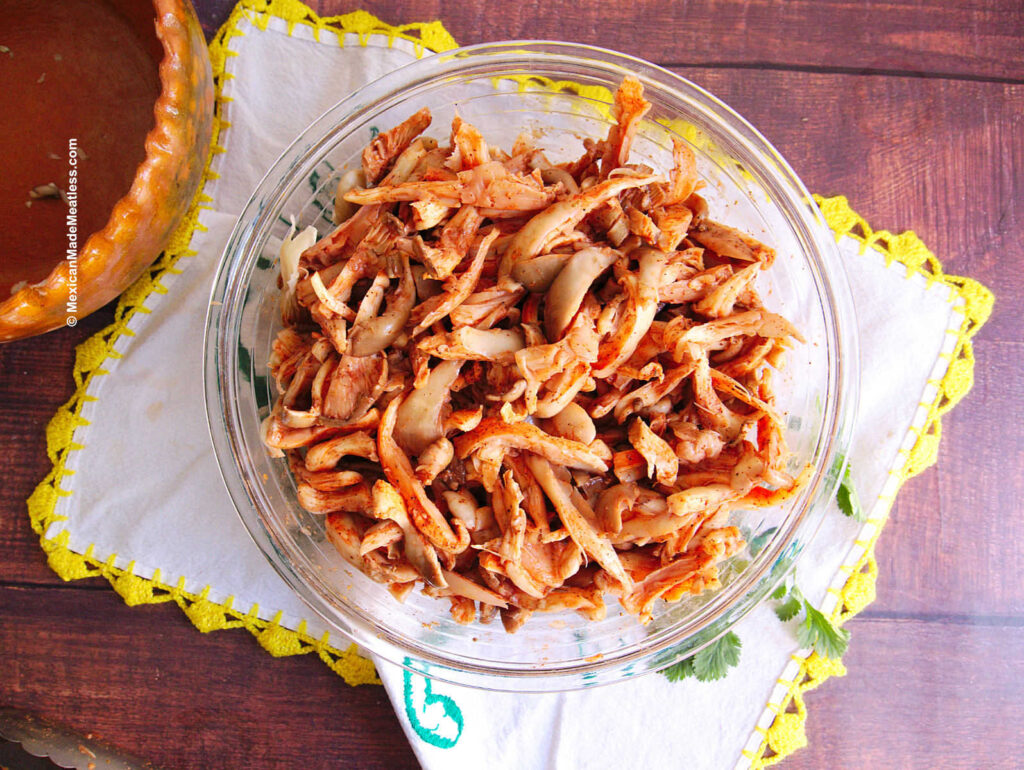
Make the achiote marinade and pour over the shredded oyster mushrooms. Marinate for at least 30 minutes.
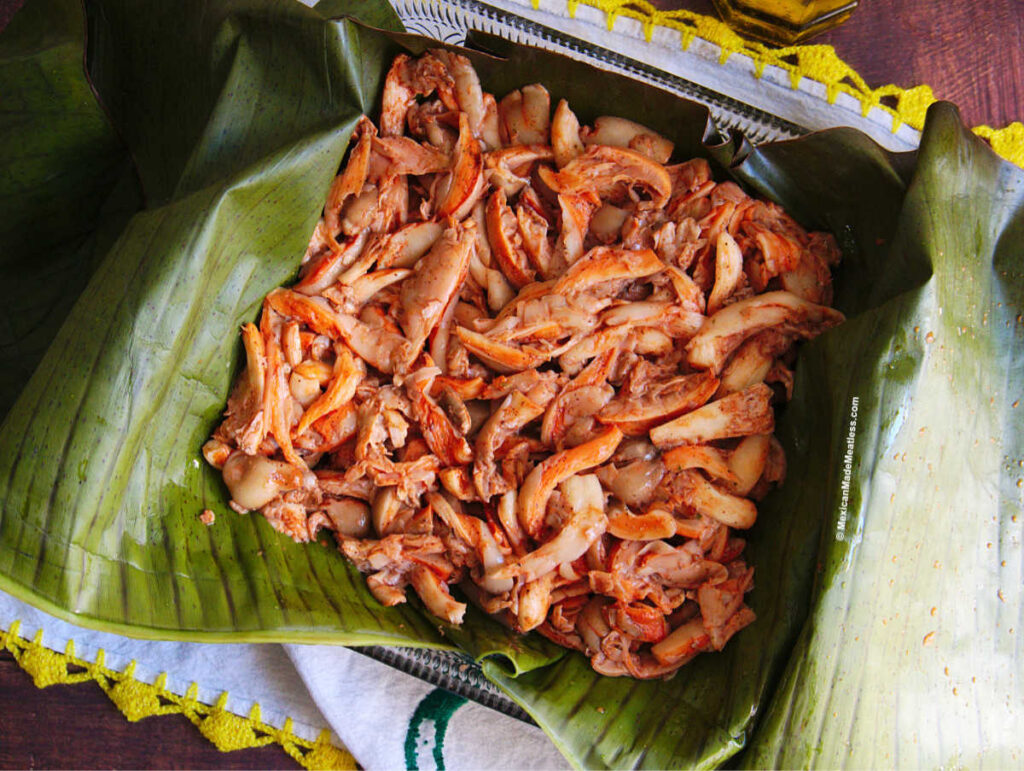
Line a baking dish with toasted banana leaves, drizzle olive oil over them, spread the marinated mushrooms over the banana leaves. Drizzle with more olive oil. Fold the excess banana leaf over the top.
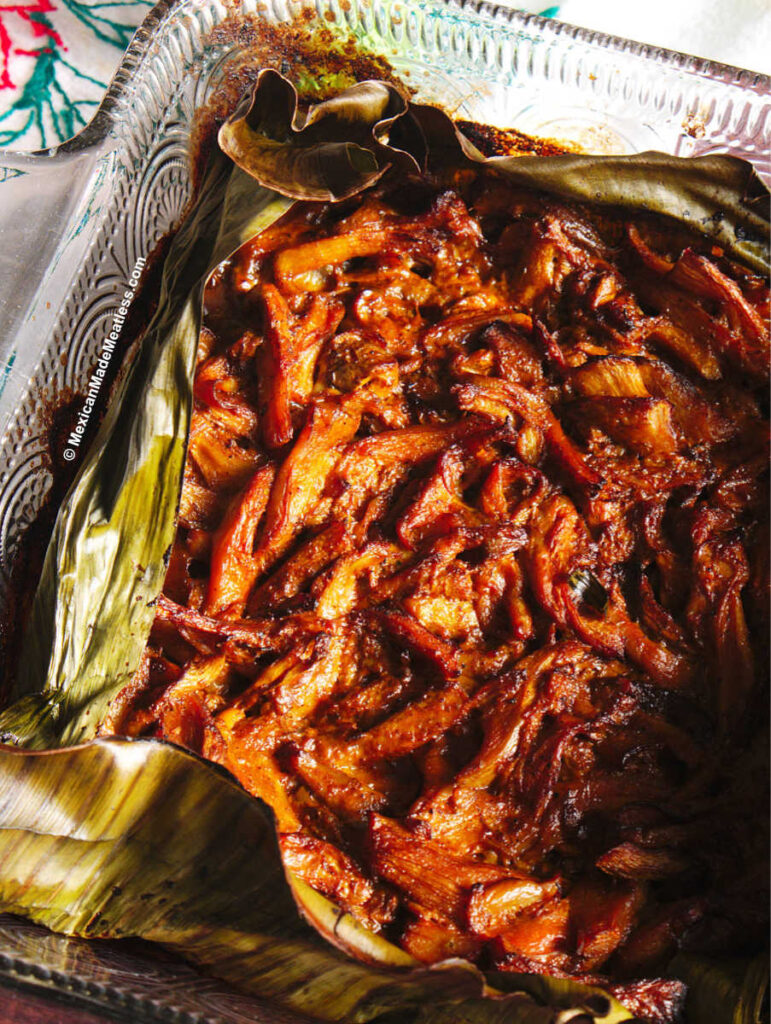
Bake for 30 minutes then mix the mushrooms, cut off the excess banana leaf and roast another 40 minutes or until most of the liquid has evaporated.
Step 2: Make The Masa

Combine the masa harina, baking powder and salt in a large bowl.
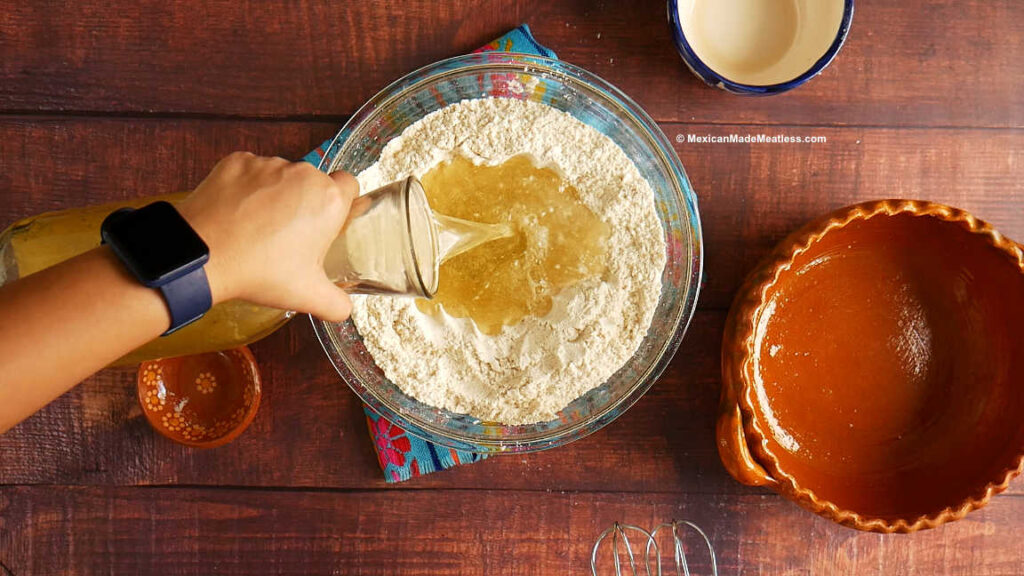
Make a well in the center of masa mixture, pour in all of the oil then add some vegetable stock.
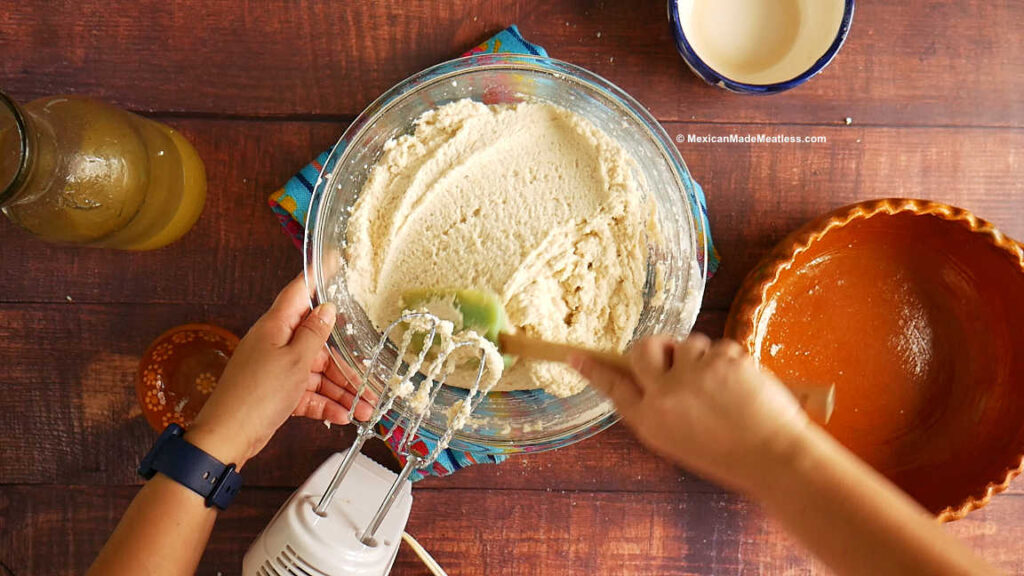
Use a hand mixer on low speed to start mixing the masa. Continue gradually adding more broth and increasing to medium speed, mixing until you have a smooth corn masa with the consistency of smooth cookie dough. Don’t forget to scrape down the bowl.
Step 3: Prepare The Banana Leaves
Slice or cut off the central stem from banana leaves. Cut to even sized square pieces that are anywhere from 6- to 8-inch segments. Rinse under warm water then use paper towels to pat dry.

Heat a comal or large frying pan then place one banana leaf square on to it and leave to soften for a couple of minutes or until the color changes to a deeper green color.
Repeat until all the pieces are softened. The leaves will become softer and pliable – don’t over cook them otherwise they’ll turn crispy and crack.
Step 4: Make The Tamales

Lay a banana leaf piece on a large cutting board then scoop a few tablespoons of the masa onto the center of the leaf. Make sure it’s on the smooth side of the leaf.
Use the back of a spoon or a wooden spoon to spread the masa into an even layer like pictured.

Add a couple of tablespoons of the cochinita pibil filling onto the center of the masa.
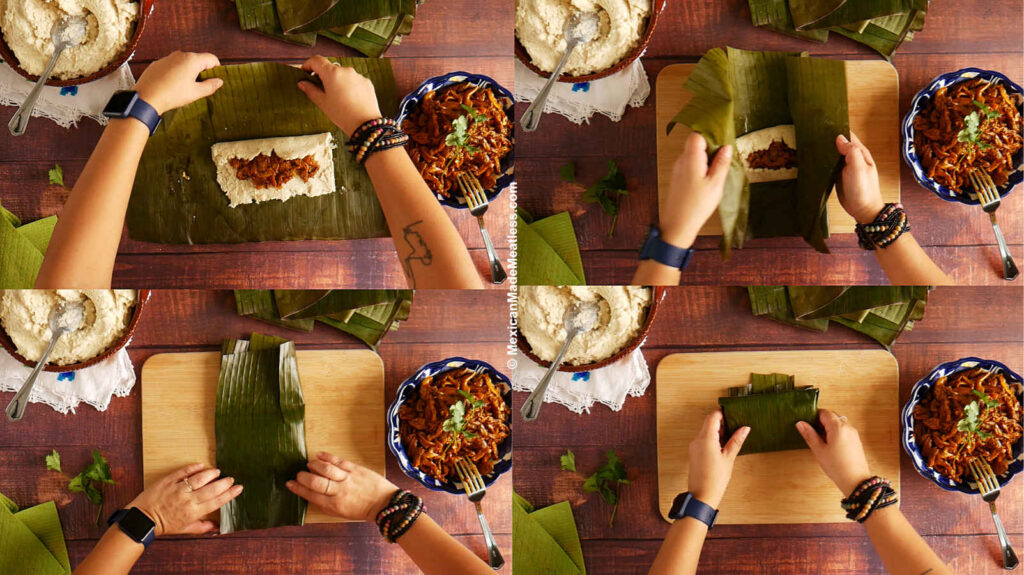
Grabbing one side of the banana leaf, fold it into the center so that it the masa overlaps onto the filling a little. Repeat for each side.
Next fold the banana leaf sides onto each other and wrap them to create a little pocket. Please watch the video for a clear visual guide.
Some people use either the hard stem that was cut off the banana leaves or a piece of kitchen string to tie around the tamales and make them prettier. I don’t do this and the Campechana woman who taught me to make these tamales also doesn’t tie them. But it’s up to you.
Step 5: Steam The Tamales
Pour in a few cups of water to the indicated line of a tamalera or steamer pot. Put the steam plate in it’s place.
Start stacking the wrapped tamales on top of the steam plate of a tamale pot. Cover the pot with aluminum foil, make a small hole in the center then put the lid on.
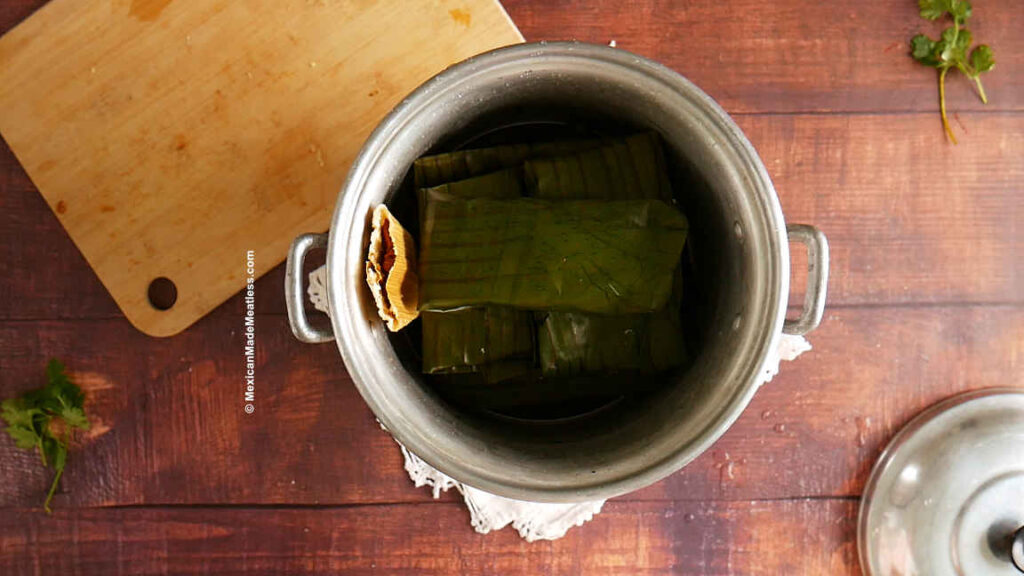
Place the pot on the stove over medium-high heat and allow the water to come to a boil. You’ll be able to tell because boiling water makes like bubbling sounds.
Once the water is boiling turn down to medium heat and steam the tamales for 45 minutes.
Carefully remove one tamale from the steamer pot and allow to sit for 10 minutes. Then unwrap it to check that it’s cooked through. The dough will be tender and peel away easily from the banana leaf.
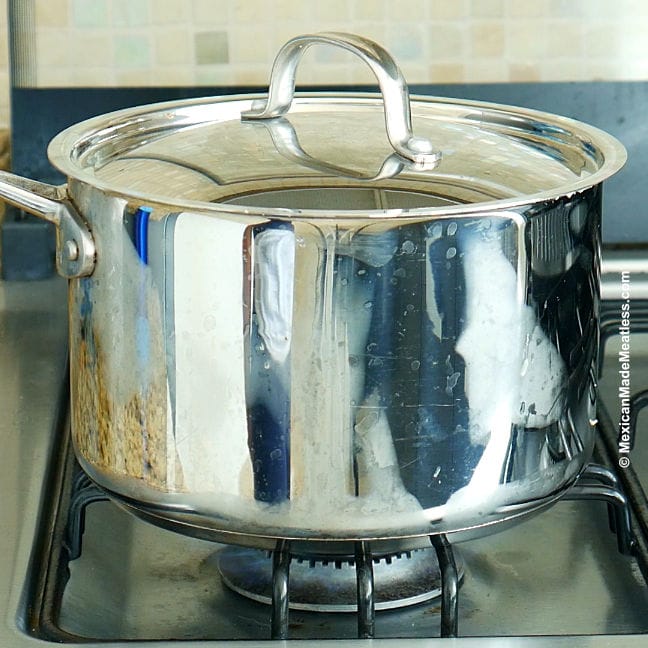
Banana Leaf Tamales Tips
- You don’t have to use masa harina to make these tamales, you can use fresh masa instead.
- If you don’t have a tamalera or tamale steamer pot you can place a steamer basked inside a large pot or even the Instant Pot. For more instructions read my article How to Steam Tamales Without a Steamer.
- Some people like to place a penny at the bottom of the steamer pot so they can tell when the water is getting low.
- Don’t be afraid to adjust the seasonings of the cochinita pibil to your liking.
- Another delicious banana leaf tamales recipe is to make them with mole sauce. I use shredded mushrooms and cook them with a simple jar of Doña Maria spicy mole paste.
- If you want to make large batches of tamales then you can make a good time out of it by inviting family and friends over for a tamale making party, aka a tamalada.
- If you have a small tamale pot or steamer pot don’t compact the tamales into it. They need room to expand. So it’s best to either use two pots or steam one batch then steam the remaining tamales afterwards.
- If you find yourself without access to packages of whole fresh banana leaves then you could make these tamales using corn husks instead. Read my guide for How to Prepare Corn Husks for Tamales.


How to Serve
These banana leaf tamales are served a bit differently than others. Since the filling is cochinita pibil we want to serve them like cochinita is eaten in the Yucatan Peninsula.
Serve with pickled red onions and a spicy habanero salsa. That’s all these incredibly flavorful banana leaf tamales need.
Like regular tamales these too can be served for special occasions or celebrations during the holiday seasons, like Mexican Christmas Eve or even Día de la Candelaria.
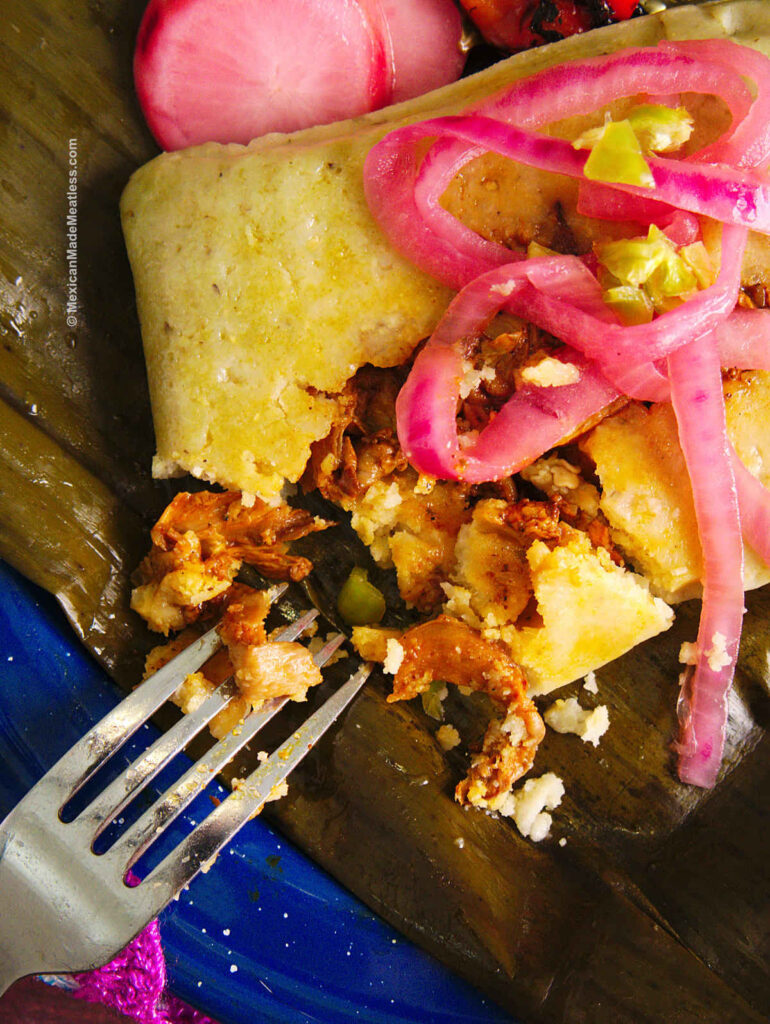
How to Store
Allow leftovers to come to room temperature then store in an airtight container in the refrigerator for up to 5 days.
You can also freeze them in large Ziploc bags for up to 3 months.
I have a whole guide on storing tamales so make sure to read it, How to Store Tamales.
How to Reheat
Cooked tamales can be reheated in a tamale steamer pot or microwaved or reheated right on a comal.
I wrote a comprehensive guide on reheating tamales that you may want to read, How to Reheat Tamales.

Banana Leaf Tamales Recipe
Amigos, with this vibrant fusion of plant-based banana leaf tamales you can still experience all the goodness and authentic flavors. Follow my step-by-step banana leaf tamales recipe so you can have flavorful meatless tamales so delicious that not only non-meat eaters will enjoy, but also even those hardcore meat-eaters will too.
Let me know if you have any questions and remember to leave me a comment and review if you try out this or any of my recipes.
Buen provecho!
Banana Leaf Tamales Recipe with Cochinita Pibil Filling
Video
Equipment
Ingredients
Tamale Dough Ingredients
- 1 lb masa harina I used Maseca brand masa for tamales
- 1.25 teaspoons baking powder (one and a quarter teaspoons)
- 1.5 teaspoons salt (one and a half teaspoons)
- 3/4 cups vegetable oil I used canola
- 3 to 5 cups vegetable stock* use your favorite brand or homemade
Cochinita Pibil Tamale Filling Ingredients
- 2.2 lbs. oyster mushrooms shredded*
- 2.5 teaspoons achiote paste
- 3 to 4 whole garlic cloves
- 2 teaspoons Mexican oregano
- 1 teaspoons ground cumin
- 1 large bay leaf crushed
- 1/4 teaspoons ground black pepper
- 1.5 teaspoons salt adjust to taste
- 1 Tablespoon olive oil
- 1/4 cup apple cider vinegar
- 1 cup orange juice
- 3 Tablespoons olive oil
- Banana leaves
You’ll Also Need
- fresh banana leaves
- pickled onions
- habanero salsa with lime juice**
Instructions
Cochinita Pibil Filling Instructions
- Shred oyster mushrooms. In a blender make the marinate with the achiote paste and all of the spices, the orange juice, vinegar and 1 Tablespoon of olive oil. Blend until completely smooth then pour over the mushrooms.
- Marinate for 30 minutes. While the mushrooms marinate you can soften the banana leaves by placing them on a hot pan and warming just until they change to a deeper green color.
- Line a baking dish with the banana leaves, rub 1.5 Tablespoons olive oil on the bottom then pour in the marinated mushrooms and drizzle with the remaining oil.
- Cover with the extra banana leaf and roast at 390F for 30 minutes. Then cut off excess banana leaf, give the mushrooms a stir. Roast for another 40 minutes or until most of the marinate has evaporated. Leave to cool before using.
Prepare Banana Leaves
- Cut away the hard center stem of the banana leaves. Then cut into individual 6 to 8 inch pieces. Rinse then pat dry completely. Then lightly toast on top of a hot pan only for a few minutes until the banana leaves turn a deeper green color. Set aside.
Tamale Dough Instructions
- In a large mixing bowl, stir the masa harina, baking powder and salt until well combined.
- Make a well in the center and add all of the canola oil and about 1 cup of the vegetable stock.
- Use a wooden spoon or a hand mixer or stand mixer or your hands to start mixing the ingredients until well incorporated. Little by little add in more vegetable stock until you have a smooth masa that feels a bit airy and spreads easily. The consistency will be like soft cookie dough or smooth creamy peanut butter.
Make The Tamales
- Spread a couple of tablespoons of the masa onto a prepared banana leaf. (see the pictures in the post)
- Then add couple tablespoons of the cooled cochinita into the center of the masa.
- Grab one of the wider ends of the banana leaf and lift and bring towards the center of the filling. You want to lift the masa onto the filling. Repeat with the remaining 3 sides.
- Next fold the banana leaf over each side to create a small pocket and pouch. (Watch the video for a visual guide.)
- Fill the steamer pot with water to the indicated line then place the steaming tray inside.
- Begin stacking the tamales inside the pot, making sure that the lid will fit in it’s place snuggly.
- Cover the pot with aluminum foil, make a small hole in the center then secure the lid on the steamer pot.
- Place on the stove over medium-high heat and once the water starts to boil reduce the heat down to medium-low. Steam for 45 minutes and add more water to the pot if necessary.
- To check for doneness carefully remove one tamale from the pot and allow to sit for 10 minutes before unwrapping. If the tamal is cooked through it will peel away from the leaf easily and the masa will fill tender but firm. If not, the masa will stick to the leaf and look soggy. At this point steam for another 15 minutes.
- Serve with pickled onions and habanero hot sauce. Enjoy!
Notes
Nutrition
(Please notice that this article contains Amazon affiliate links, which may earn us a small commission if you make a purchase through them. Your support helps us continue to provide valuable content.)
Nancy Lopez is a food blogger and author of the cookbook Mexican Tamales Made Meatless. Born in Mexico, raised in the US, and currently living in Southern Mexico, she has followed a meatless diet for almost 10 years. It is her passion and mission to share all she has learned about vegan Mexican cooking and vegetarian Mexican recipes. Mexican Made Meatless is a blog dedicated to preserving the authentic flavors of Mexican cuisine just without the meat. It’s a place to celebrate Mexican culture and all it’s delightfully delicious traditional foods. Read more…


